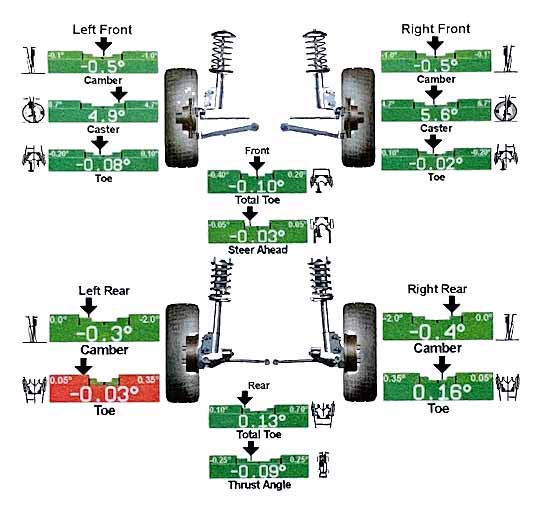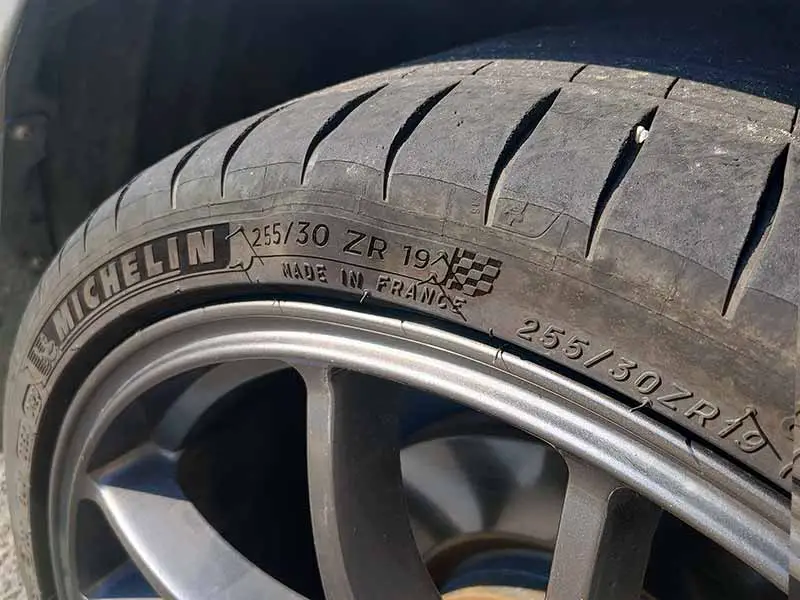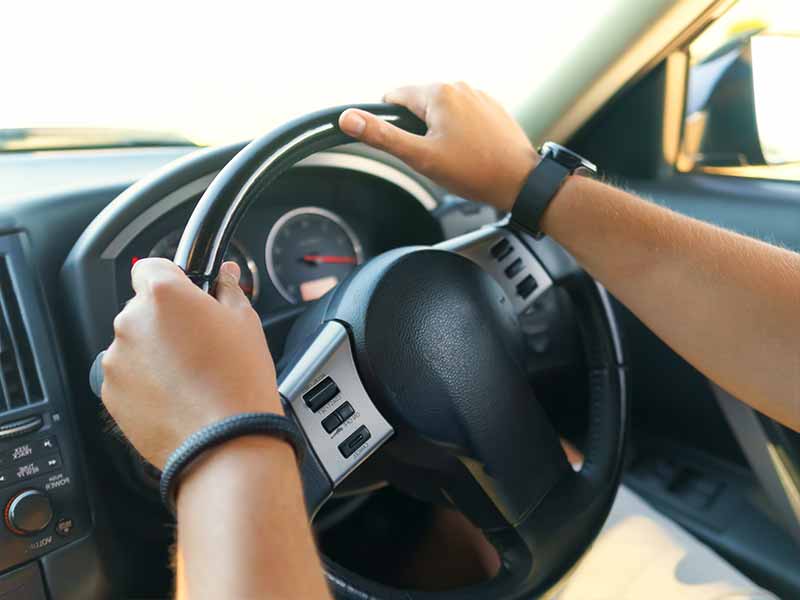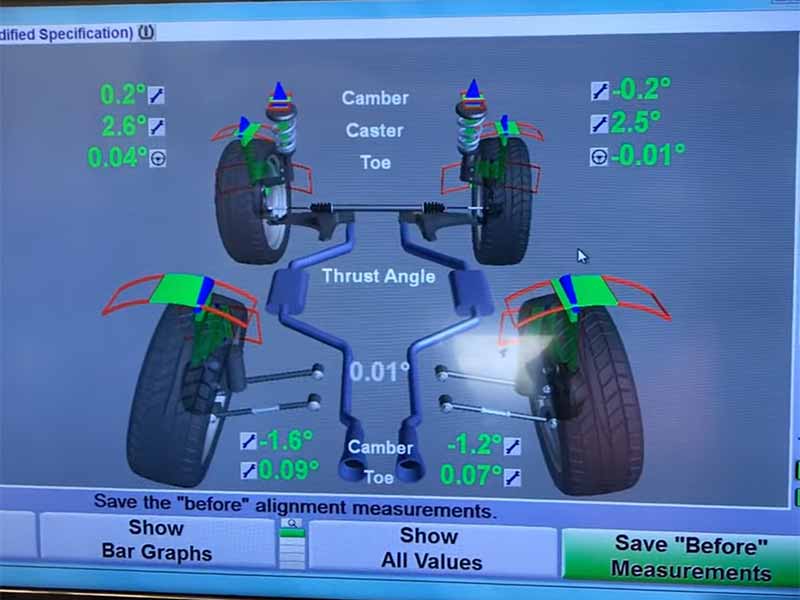If your car drives worse after an alignment is performed, you have a right to be concerned. Alignments are one of the more expensive tire maintenance services and can have a serious impact on handling and tire wear.
How To Know If Alignment Is Done Right
You can check your alignment at home with a tape measure alignment check or while driving by ensuring your car or truck drives in a straight line on a flat and level road and the steering wheel isn’t off center.
These are ballpark methods but can give you a good idea of the accuracy.
The alignment printout you receive when the job is complete will give you the raw numbers. But sometimes, these can be a bit misleading.
Let’s take a closer look.

How To Check Wheel Alignment While Driving
Pick a straight, flat road, and make sure you’re driving straight. Take note of any vibrations or pulling that you feel in the steering wheel or seat.
Take your hands off the wheel and see if the vehicle stays straight or pulls to one side. This can indicate an alignment issue, especially if the pull is strong or persistent.
While driving in a straight line, ensure the steering wheel is centered and not crooked.
How To Check Wheel Alignment At Home
It’s possible to get a reasonably good idea of the Toe-In alignment by measuring distances between your tires:
Tape Measure Alignment Check
To begin, measure the distance between the center of the front tires, then measure the distance between the center of the rear tires. Next, you’ll want to measure the distance between the center of the front tires and the center of the rear wheels on the same side of the car. If the measurements are off by more than 1/4 inch, it could be a sign that your car or truck’s alignment is off.
Of course, this is just a basic check, and it’s always best to have another professional perform a full alignment check to get the most accurate reading if you’re not satisfied with the current alignment results.
Car Still Pulls After Alignment
If you’ve recently gotten your car aligned and it’s still pulling to one side or the other, you’re not alone. There are a few things that could be causing it.
Here are a few things to keep in mind:
Incorrect Alignment
Even if your car was recently aligned, there’s a chance that it wasn’t done correctly. It’s always a good idea to double-check with a trusted mechanic to make sure everything was done correctly.
If you suspect your wheel alignment wasn’t performed correctly, the best course of action is to take your vehicle back to the shop where the alignment was done and have them recheck it. A good technician should be able to detect any issues and make the necessary adjustments.
If unsatisfied with the results, try using a different alignment shop. If you can find a mechanic specializing in wheel alignments, you will be more likely to get a better result. You may also want to get a referral from your regular mechanic.
Suspension Problems
If your suspension is worn or damaged, it can cause your car to pull to one side or the other, even if your tires are correctly aligned.
Here’s a quick rundown of the key suspension components that can impact your alignment:
- Control Arm Bushings
- Ball Joints
- Tie Rod Ends
- Sway Bar Links
These components act as pivot points that connect the suspension to the wheels and allow them to move up and down. Over time, they can become worn or damaged due to various factors, including normal wear and tear, driving over rough roads, or hitting potholes.
When these components are damaged, they can cause the wheels to become misaligned and result in a variety of handling issues, including poor steering response, uneven tire wear, and even excessive tire wear.
In some cases, these problems can be corrected with an alignment, but in more severe cases, you may need to replace the damaged suspension components to restore proper alignment.
Uneven Tire Pressure
Make sure all four of your tires have the same pressure. If they don’t, your car could pull to one side or the other.
When your tire pressure is off, it can cause your vehicle to sit unevenly, which in turn, throws off your alignment. For example, if your front tires have more pressure than your rear tires, it can cause your vehicle to pull to one side. This uneven pressure can also cause your tires to wear down more quickly on one side, which is never good.

So, what can you do to prevent this from happening? First and foremost, it’s important to regularly check your tire pressure and make sure it’s at the recommended level for your vehicle. You can find this information in your owner’s manual or on the door jamb of your car.
Worn Or Damaged Tires
If your tires are worn or damaged, they can cause your car to pull to one side or the other, even if your alignment is correct.
For example, if your tires are under-inflated, they will be more prone to flex and sidewalls folding over, which can cause the vehicle to pull to one side or the other and cause a loss of stability.

Off Center Steering Wheel After Alignment
Why might you be seeing a crooked steering wheel after an alignment? Well, there are a few possible causes.
It’s possible that the alignment wasn’t performed correctly in the first place. Maybe the technicians didn’t properly measure your car’s alignment angles or made a mistake during the adjustment process. If this is the case, you may need to take your vehicle back to the shop for a re-alignment.
Another possible cause of a crooked steering wheel after an alignment is that you have worn or damaged suspension components. Your suspension system is what helps to keep your car’s wheels in contact with the road, and it also helps to absorb shock and vibrations. If you have worn or damaged suspension components, it can make it difficult for your wheels to stay properly aligned, even after you’ve had an alignment performed.

Finally, it’s also possible that your tires are causing the problem. If you have uneven tire pressure or if your tires are worn or damaged, they can affect the alignment of your wheels and cause a crooked steering wheel. You may need to have your tires balanced or replaced to fix this.
How Far Out Of Alignment Is Bad?
It’s important to understand what each of the alignment angles means.
- Camber refers to the tilt of the wheels, either inward or outward, as viewed from the front of the vehicle.
- Caster is the angle of the steering axis, which affects how easily the wheels can turn.
- Toe refers to the angle of the tires in relation to the vehicle’s centerline.
- Thrust Angle is the direction the rear wheels are pointing in compared to the vehicle’s centerline.
Ideally, you want these angles to be within the manufacturer’s recommended range for your specific vehicle, as deviations from that range can cause problems. For example, if the camber is too far out of range, it can cause uneven tire wear and poor handling. The same goes for caster, toe, and thrust angle – if they’re not in the proper range, it can cause problems with steering, handling, and tire wear.
So, how far out of range is “bad“? It really depends on the vehicle and the manufacturer’s specifications. Generally, a slight deviation from the ideal “green” range might not have a noticeable impact, but larger deviations into the “red” can cause significant problems.
The bottom line is if you’re experiencing any issues with your vehicle’s handling, steering, or tire wear, it’s a good idea to have a professional check the alignment angles and see if they’re within the proper range.
How To Read A Wheel Alignment Report
Camber refers to the angle at which the tires are positioned in relation to the road. Caster refers to the angle of the steering axis, and toe refers to the angle of the wheels in relation to the vehicle’s centerline. Finally, the thrust angle refers to the direction in which the car or truck pulls.
It’s important to note that each of these specs has a recommended range of values that indicate a properly aligned vehicle. If any of these values are outside the recommended “green” range, your car or truck is not aligned correctly according to the vehicle manufacturer’s guidelines. But measurements slightly in the “red” may not be cause for concern.
Your report will usually include the before and after values for each of the four specs, so you can see the changes made during the alignment process.
Also, you may see notes about any issues the technician noticed or any additional services that may be required. Worn or damaged steering or suspension components can prevent wheel alignment adjustments from being adjusted to spec.
Age, wear and tear, and accidents call all affect alignment and prevent various angles from being adjusted to the proper alignment specs.
Resources
Below are some links you may find helpful when learning about tires
Final Thoughts
To make sure your alignment is done right, you should always check the numbers on the alignment report to see if they’re within the proper range for your vehicle. Take your vehicle for a test drive to see if it feels good and drives straight.
If you’re unsure, you can always take it back to the shop and have them recheck it. Remember, proper alignment is important for a smooth ride, good handling, and extended tire life, so it’s worth taking the time to make sure it’s done right.
Good luck and happy motoring.






